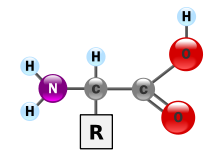
Back بروتين (تغذية) Arabic আমিষ Bengali/Bangla Proteïna (nutrient) Catalan پرۆتین (خۆراک) CKB Протеин CV Πρωτεΐνη (τρόφιμο) Greek Proteína (nutriente) Spanish پروتئینها در رژیم غذایی Persian Protide French प्रोटीन ( पोषक तत्व ) Hindi


Proteins are essential nutrients for the human body.[1] They are one of the building blocks of body tissue and can also serve as a fuel source. As a fuel, proteins provide as much energy density as carbohydrates: 17 kJ (4 kcal) per gram; in contrast, lipids provide 37 kJ (9 kcal) per gram. The most important aspect and defining characteristic of protein from a nutritional standpoint is its amino acid composition.[2]
Proteins are polymer chains made of amino acids linked together by peptide bonds. During human digestion, proteins are broken down in the stomach to smaller polypeptide chains via hydrochloric acid and protease actions. This is crucial for the absorption of the essential amino acids that cannot be biosynthesized by the body.[3]
There are nine essential amino acids which humans must obtain from their diet in order to prevent protein-energy malnutrition and resulting death. They are phenylalanine, valine, threonine, tryptophan, methionine, leucine, isoleucine, lysine, and histidine.[2][4] There has been debate as to whether there are 8 or 9 essential amino acids.[5] The consensus seems to lean towards 9 since histidine is not synthesized in adults.[6] There are five amino acids which humans are able to synthesize in the body. These five are alanine, aspartic acid, asparagine, glutamic acid and serine. There are six conditionally essential amino acids whose synthesis can be limited under special pathophysiological conditions, such as prematurity in the infant or individuals in severe catabolic distress. These six are arginine, cysteine, glycine, glutamine, proline and tyrosine.[2] Dietary sources of protein include grains, legumes,[7] nuts,[8] seeds,[7] meats, dairy products, fish, eggs, edible insects, and seaweeds.[9]
- ^ Cite error: The named reference
proteinbodywas invoked but never defined (see the help page). - ^ a b c Cite error: The named reference
DRIProteinChptwas invoked but never defined (see the help page). - ^ Genton L, Melzer K, Pichard C (August 2010). "Energy and macronutrient requirements for physical fitness in exercising subjects". Clinical Nutrition. 29 (4): 413–23. doi:10.1016/j.clnu.2010.02.002. PMID 20189694.
- ^ Young VR (August 1994). "Adult amino acid requirements: the case for a major revision in current recommendations" (PDF). The Journal of Nutrition. 124 (8 Suppl): 1517S – 1523S. doi:10.1093/jn/124.suppl_8.1517S. PMID 8064412.
- ^ Rosane Oliveira, "The Essentials–Part One", UC Davis Integrative Medicine, Feb 4, 2016. July 12, 2017.
- ^ Kopple JD, Swendseid ME (May 1975). "Evidence that histidine is an essential amino acid in normal and chronically uremic man". The Journal of Clinical Investigation. 55 (5): 881–91. doi:10.1172/jci108016. PMC 301830. PMID 1123426.
- ^ a b "High-Protein Alternatives to Meat". Pocket. Retrieved 9 June 2022.
- ^ "Protein in diet". United States National Library of Medicine, National Institutes of Health. 2009.
- ^ Reynolds, Daman; Caminiti, Jeff; Edmundson, Scott; Gao, Song; Wick, Macdonald; Huesemann, Michael (12 July 2022). "Seaweed proteins are nutritionally valuable components in the human diet". The American Journal of Clinical Nutrition. 116 (4): 855–861. doi:10.1093/ajcn/nqac190. ISSN 0002-9165. PMID 35820048.